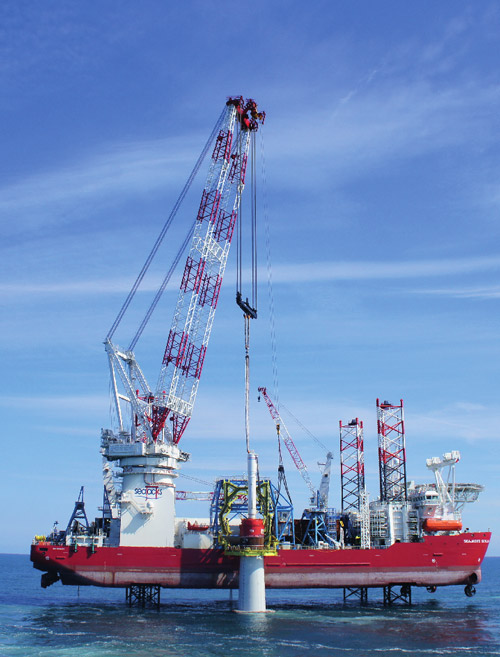
Offshore wind park Veja Mate
67 turbines with a combined capacity of 402 MW. Offshore wind park Veja Mate lies in the German part of the North Sea, at 130 kilometres to the north of the Eemshaven. The park will soon have sufficient capacity to provide 400,000 German households with sustainable energy. Boskalis, via an EPCI contract, is responsible for the design, purchasing, construction, transport and installation of the 67 foundations. 1300 tonnes per unit, 84 metres tall, 7.8 metres in diameter… Based on the numbers alone, it’s no wonder that the monopiles for the Veja Mate foundations received the predicate ‘XXL’. An entire metro-car could easily fit inside each one. The piles span an average water depth of forty meters and were driven tens of meters into the seabed. ‘A challenging project’, tells Danny Kruit from Boskalis, ‘and unique in many ways!’
Big tools
Danny has been involved with the project since day one. Before becoming responsible for the implementation as Monopile Installation Manager, Danny was Tender Manager. ´In the tender phase, the decision in our favour was ultimately based on the vessel, the crane and the hammer we proposed. We had to prove that we had the right materials for the assignment.’ A project located far off the coast has to deal with considerable swell at sea and that is why a floating vessel – due to the expected downtime – was not an option. ‘We ended up going for Seajacks’s new jack-up installation vessel, Scylla’, explains Danny. ´The Scylla is currently the largest and most advanced vessel for this type of work. Also the crane and the hammer are unique. The hydraulic hammer from IHC, for example, with its four thousand kilojoules is the largest of its kind and we have increased the lifting capacity of the crane to 1540 tonnes, compared to the usual 1500 tonnes. Just enough power to lift the piles and to withstand the dynamic effects of the water for safe installation.’
Team building
A lifting system to up-end the piles to vertical. A double gripper that holds the pile upright and levels the lateral forces while driving it into the seabed. A special tool to measure the effect of piling on the flange to which later the transition piece (connection between foundation and windmill) is mounted… For this project, there was no tool readily available. In the relatively short time period between the financial close and the start of the project – approximately 9 months – everything had to be designed, developed, fabricated and installed. ‘A race against the clock, but thanks to the commitment of all parties we managed it! On April 4, 2016, we installed the first monopile’, Danny shares. ´During the crewing weekend, we went through all of the procedures together. And the people of TOS and
Boskalis were able to get to know each other well before the project
began. The bonds between the different nationalities and groups
really grew in that weekend.’
Bubble curtain
The monopiles for Veja Mate were manufactured in Rostock and transported three at a time from the feeder port at Eemshaven to the project location. From there the duration of the whole cycle from positioning, lifting, up-ending, turning, gripping, piling and repositioning took about 16 hours for each pile. The piling lasted about 2,5 hours. ‘It was decided to make use of reduced-energy piling in order to protect the flora and fauna in the German waters. Otherwise one hour per pile would have probably been feasible with this hammer’, Danny calculated. This was not the only noise mitigation measure taken by Boskalis. ‘Working with compressors, for example, we laid out a double bubble curtain around the location where the monopile was to be installed. Also, a forty-metre long net with foam and air chambers around the pile helped to further reduce the noise. At the beginning of the project, the permits were granted for each individual pile, so for the progress of the project it was very important to stay within the agreed level of 160 decibels.’
The final monopile was installed on August 13, 2016.
Danny looks back with satisfaction: ‘Our part of the job is complete. We successfully managed to deliver the monopile installation works on time and within tolerance. Something we are very proud of!’ The final transition piece was installed late October, marking the end of the Boskalis offshore activities.

Danny Kruit
Monopile Installation
Manager bij Boskalis
